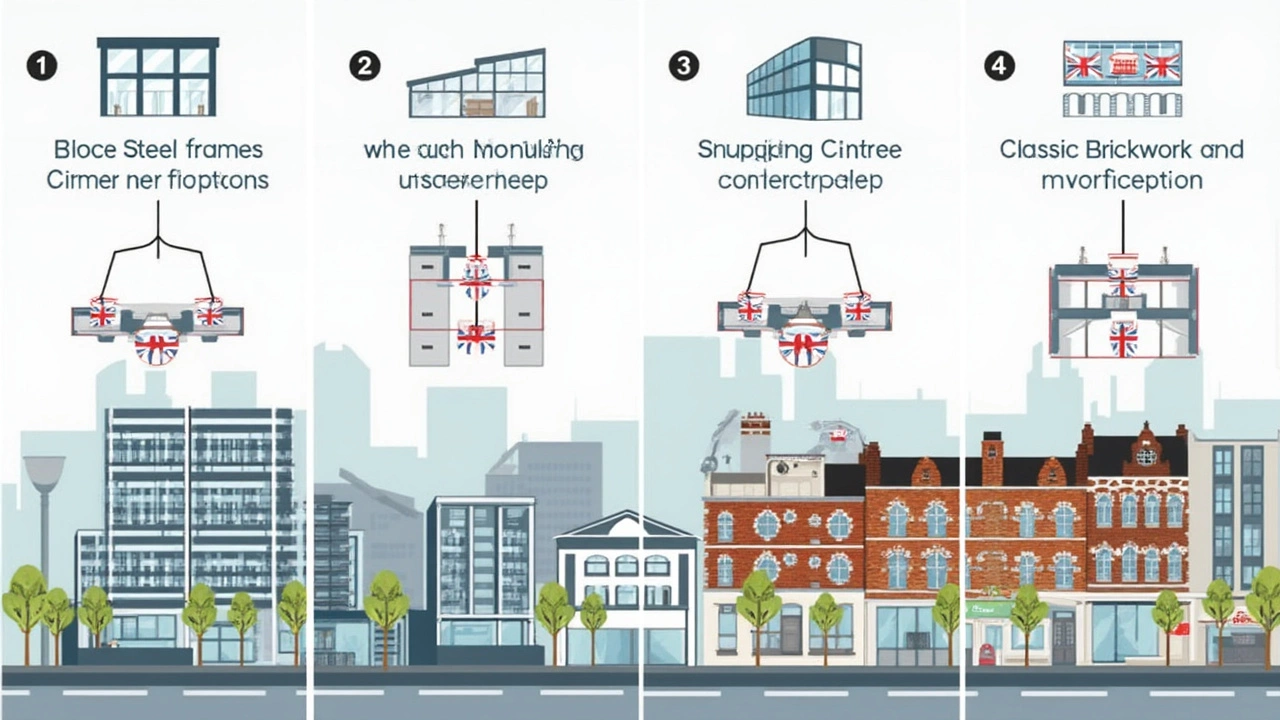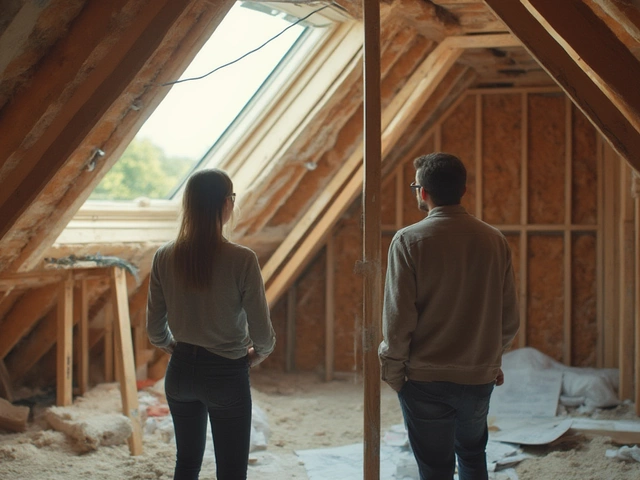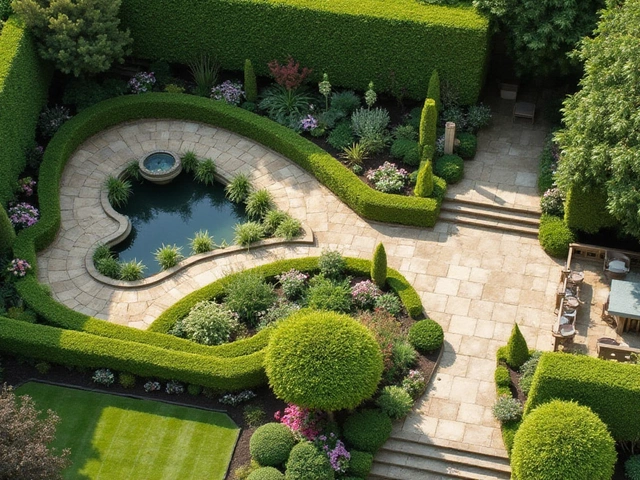If you picture any city skyline, every tower started with a choice: what’s the smartest, fastest way to build it? The methods used in commercial construction can make or break the budget, timeline, and even the look of the final building. Real estate developers lose sleep over this stuff, because picking the wrong approach eats into profits and sends schedules off the rails.
Right now, steel framing rules for most high-rise buildings—think offices, hotels, and big apartment blocks. Why? Steel goes up fast, handles big loads, and lets architects get creative with open spaces. But it's not always the cheapest, and if you’re in a smaller town, local labor might not have the right experience. For big box stores or warehouses, concrete tilt-up panels get a lot of hype. Crews pour the walls flat on the ground, then lift them into place—saves money and skips weeks of scaffolding drama.
- Concrete and Steel: The Backbone Approaches
- Tilt-Up Construction: Fast Walls, Big Results
- Modular and Prefab: Building Smarter, Not Harder
- Traditional Brick and Block: Where They Still Shine
- Choosing the Best Method for Your Project
Concrete and Steel: The Backbone Approaches
When most people think about commercial construction, they picture sturdy concrete and steel skeletons rising out of the ground. This combo forms the base of just about every multi-story office, hospital, mall, or factory you see.
Concrete is everywhere because it's strong, fire-resistant, and works for floors, columns, and foundations. There are a few ways it's used. Cast-in-place (poured onsite) is super common for foundations and massive floor slabs. Precast concrete, made offsite and trucked in, speeds things up and gives more control over quality. Steel, on the other hand, is all about speed and flexibility. A steel frame can be made in advance, bolted together at lightning pace, and lets you design wide-open interior spaces without chunky columns in the way.
Here's a quick look at how these two stack up for big projects:
| Method | Strengths | Typical Uses | Speed |
|---|---|---|---|
| Steel Frame | Fast, flexible, big open spaces | High-rises, stadiums, shopping centers | 4–8 months for mid-rise |
| Cast-in-Place Concrete | Strong, great for weight, fire-resistant | Parking garages, hospitals, data centers | 6–10 months for the same size |
| Precast Concrete | Quick to install, consistent quality | Warehouses, big box stores, schools | Even faster than cast-in-place |
Fun fact: The tallest buildings in the world—like the Burj Khalifa and Shanghai Tower—rely on special high-strength concrete for their cores, while the outer structure mixes in tons of steel for flex and support.
If you're planning a large-scale build, there are some simple tips to keep in mind:
- Steel often saves time (and money) on labor, but raw material prices can bounce around a lot.
- Concrete is cheaper locally in places with cement plants nearby. Transport costs matter.
- Mixed builds are common—steel for the main frame, concrete for floors and foundations.
- Building codes might steer your choice. Some locations demand extra fire resistance or earthquake safety, which impacts your options.
Don't forget, the right choice also comes down to the skills of your local crews. Experienced concrete finishers or steelworkers make a huge difference on the job site.
Tilt-Up Construction: Fast Walls, Big Results
No other method looks quite as cool on a jobsite as tilt-up construction. Imagine huge concrete walls being cast right on the ground, then lifted into place all in a single day. It's not just dramatic—it’s efficient. Tilt-up is a go-to for warehouses, retail stores, and office parks, mostly because it cuts down on time and labor compared to traditional block-by-block building.
Here’s the basic rundown on how it works:
- The crew lays out forms directly on the slab (that's the future building floor).
- They pour concrete into these molds, reinforcing with steel bars.
- Once those panels cure, cranes lift them upright and set them into place. Braces hold them steady while crews tie everything together.
It sounds simple, but speed is the real perk. Companies using tilt-up save weeks—sometimes months—when compared to building walls with brick or block. That time saved means less money spent on labor, less risk from weather delays, and a quicker path to getting tenants or businesses moved in.
Cost-wise, tilt-up construction can cut expenses by 10-20% versus old-school masonry, depending on job size and local wages. But it really shines on big, single-story buildings—less so for tall or super complex designs.
Just check out these numbers from Construction Industry Institute surveys:
| Factor | Typical Masonry | Tilt-Up Construction |
|---|---|---|
| Average project length (SQ FT: 50,000) | 20-24 weeks | 12-16 weeks |
| Labor cost (per SQ FT) | $15-$18 | $8-$10 |
| Energy efficiency | Medium | High (better insulation) |
This approach isn't a fit for every job. Cold climates or earthquake zones sometimes mean you need extra engineering. Local codes and the experience of your contractors matter a ton. But when it works, tilt-up is tough to beat for speed and cost, especially in commercial construction where deadlines and budgets are tight.

Modular and Prefab: Building Smarter, Not Harder
If you want to cut down on mess and surprises at the job site, modular and prefab construction just makes sense. Here’s how it works: most of the building gets made in a factory, then delivered in pieces—kind of like super-sized LEGO. You connect these big sections, do a bit of wiring or plumbing on site, slap on the finishing touches, and you’re off to the races.
Why do developers love modular for commercial buildings and hotels? Speed. You can prep the foundation while the factory builds the modules. So, projects get done 30–50% faster than with old-school methods. That’s huge if you need rooms ready for tenants or want to open a shop before the next big holiday season.
- Less weather risk – Walls and roofs are built indoors, so fragile stuff isn’t left out in the rain or snow.
- Consistent quality – Factory crews use jigs and detailed plans. Fewer mistakes slip through.
- Less waste – Modules are made using exact amounts, which means dumpster costs drop.
- Cleaner sites – Less dust and noise for neighbors. Good for urban projects.
Here’s a neat stat: Marriott aimed to build about 50 new hotels per year using modular construction by 2025. That’s how much this approach has caught on, especially for repeatable designs like hotels, apartments, or dorms.
Of course, it’s not perfect. Shipping giant modules needs decent roads and open job sites. Unique or super-custom buildings might be too weird for modular solutions. And while prices keep getting better, some local markets are slow to catch on.
| Method | Average Build Time (weeks) | Waste Reduction | Common Use |
|---|---|---|---|
| Modular Construction | 16–24 | Up to 90% less than traditional | Hotels, apartments, classrooms |
| Traditional Construction | 32–52 | Standard | All building types |
If you want quicker returns and fewer on-site headaches, modular really feels like the future for a lot of commercial construction.
Traditional Brick and Block: Where They Still Shine
Even with all the hype around steel and concrete, brick and block construction still gets plenty of attention for certain types of commercial construction. Walk around older parts of town, and you’ll see schools, fire stations, and office buildings built with this method. It’s tried and true, and that’s part of the appeal—people know what they’re getting, and local masons know the craft inside out.
Masonry construction is all about stacking bricks or concrete blocks with mortar. It sounds simple, but the results can last a hundred years with barely any maintenance. One big reason brick and block don’t disappear: they’re great for insulation and fire resistance. For businesses that store sensitive equipment or lots of paperwork—like banks or archives—those solid walls are a huge plus. They’re also the go-to for buildings in tornado zones, since thick brick and block can take a beating.
This method leans on local materials, which keeps transport costs down. Plus, if something does go wrong—say, one section develops a crack—it’s way cheaper and easier to fix a wall of brick than a huge steel frame. That’s gold for restaurants and small shops that can’t afford long shutdowns.
- Durability: Many brick-and-block buildings from the 1800s are still standing and in use.
- Thermal Mass: Thick masonry walls help balance indoor temps, which cuts energy bills.
- Custom Looks: Architects get tons of design freedom with different shapes and colors.
- Soundproofing: Brick and block soak up outside noise, handy for buildings near busy roads.
But there are drawbacks. Brick and block walls take longer to put up, and weather delays can kill your schedule. You also need skilled masons, and in some places, those folks are retiring faster than new ones learn the trade.
| Factor | Brick and Block | Steel/Concrete |
|---|---|---|
| Speed (sq ft/week) | 800-1,200 | 2,000-4,000 |
| Average Wall R-value | 0.8 per inch | 0.1-0.4 per inch |
| Fire Resistance | Excellent | Good |
| Maintenance Cost (20 yrs) | Low | Moderate |
Bottom line: brick and block still work well for projects needing classic looks, strong security, and lower lifetime maintenance. If time is your main worry, though, consider other methods. But if you want something that lasts and stands out, you can’t beat the classics.





